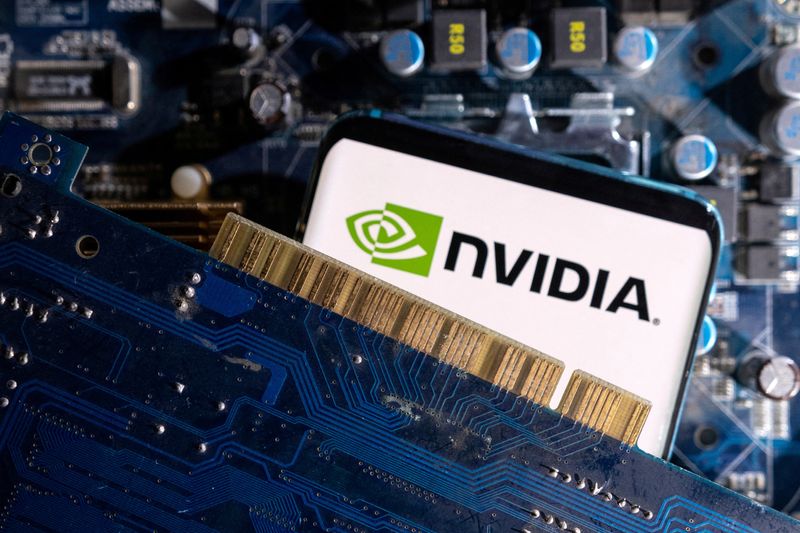Who is Kevin Hassett? Wolfe looks at the Trump ally tipped to become Fed Chair.
Investing.com -- "The next industrial revolution has begun."
That was the declaration from Nvidia (NASDAQ:NVDA) Chief Executive Jensen Huang following yet another quarter of bumper earnings from the semiconductor group earlier this month.
Revenue in the three months to April 28 soared by 262% from a year ago to $26 billion, beating Wall Street estimates of $24.7 billion, even as California-based Nvidia faces increasing competition from rivals like AMD and Intel (NASDAQ:INTC). Data center revenue, which roughly translates to Nvidia's all-important artificial intelligence chips, spiked by 427% year-on-year to a record $22.6 billion.
Adjusted earnings per share, meanwhile, came in at $6.12, up from $1.09 a share a year earlier and above analyst estimates of $5.58 a share.
What does Nvidia do?
It was the latest blockbuster return for Nvidia, whose data center graphics processing units (GPUs) have become essential parts of the architecture undergirding the development of generative AI products.
According to analyst estimates cited by Reuters, Nvidia now controls roughly 80% of the market for GPUs, the chips that power the computers that process the data and perform the specific complex mathematics needed to fuel AI. More generic central processing units, such as those made by Intel, can undertake a wider-range of tasks but less efficiently.
The company's customers reportedly include some of the most high-profile names in Big Tech like electric vehicle manufacturer Tesla (NASDAQ:TSLA) and OpenAI, the maker of the mega-popular AI chatbot ChatGPT.
Nvidia's performance has become an indicator of the course of future demand for the nascent technology, with the firm's products sometimes compared to the picks and shovels used by prospectors in California's gold rush in the mid-1800s. As a result, any earnings and announcements out of the group are now closely monitored on Wall Street.
Nvidia Price Today
Supported by the runaway hype around AI, Nvidia's share price has spiked by about 132% so far in 2024 and roughly 195% over the past one-year period.
The surge led the business to announce a ten-for-one forward stock split starting on June 7. Nvidia said the move will help make owning its shares "more accessible to employees and investors."
It also hiked its quarterly cash dividend by 150% to $0.10 per share.
Nvidia Stock Forecast
In the current quarter, Nvidia expects group-wide revenue to continue growing to $28 billion, plus or minus 2%. Analysts had pencilled in a quarterly forecast of $26.8 billion. Adjusted gross margin is expected to come in at 75.5% for the second quarter.
Goldman Sachs analysts said both metrics "met elevated investor expectations."
Is Nvidia A Risky Investment?
Despite Nvidia's position at the center of the boom in enthusiasm over AI, its dominance is coming under threat from mega-cap players like Amazon (NASDAQ:AMZN), Google-owner Alphabet (NASDAQ:GOOGL) and Facebook-parent Meta Platforms (NASDAQ:META). These firms have said they plan to increasingly funnel money into building out their AI capabilities.
Nvidia also faces risks from stiffening competition from its more immediate rivals such as Intel and Advanced Micro Devices (NASDAQ:AMD), as well as upstarts like GraphCore, Sambanova and Cerebras, according to Sandeep Rao, Senior Researcher at Leverage Shares.
"While Nvidia's strong inroads in corporate sales provide some justification for a premium over the price ratio of peers, current price ratio levels indicate heavy overvaluation considering closing competition vis-a-vis average corporate needs," Rao said.
The wider outlook for GPU purchases by "everyday" consumers is "running flat and trending bearish" and corporate demand is "mixed-to-bullish," Rao argued.
"Sales cycles will tend to show smaller surges since the sunk cost on existing infrastructure will require rationalization before additional requisitions can be made," he said. "On the other hand, rising AI deployments are essentially nudging towards price-efficient trillion-parameter computation capabilities, which Nvidia is square in the center of."
Meanwhile, disruption to Nvidia's guidance could come from China, which Rao noted is a crucial source of the raw materials needed by Nvidia's main foundry partner Taiwan Semiconductor, or TSMC. In particular, he highlighted possible issues posed by U.S. restrictions on cutting-edge exports to China.
"A trillion-parameter computation proficiency is "supercomputer" territory, and the U.S. regulatory regime has long been cagey about permitting supercomputer exports to other nations," Rao said. "Thus, Nvidia's research excellence - ironically - puts a damper on its potential ability to make sales inroads outside of the Western Hemisphere, which is key for continued sales success."
Discover more about Nvidia and other AI stocks
Looking to assess the performance of other AI stocks? Our dedicated page offers a comprehensive list of alternative AI companies spanning various industries and technologies. Assess the performance across popular AI stocks including Nvidia (Learn more: What is Nvidia?)
